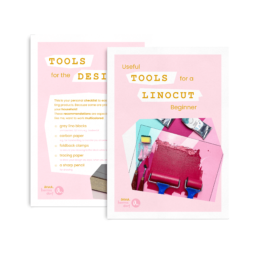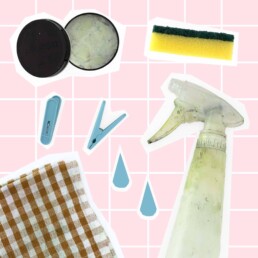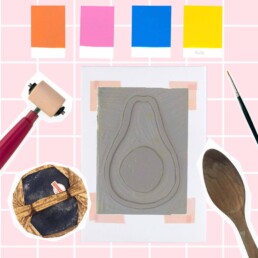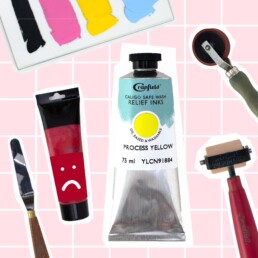Beginner's mistake No. 5
Beginner's mistake #5
Here I have a beginner’s mistake that really hurts – but not physically this time. Cleaning our utensils is part of printing, that’s for sure. But even here, you can make a critical mistake that will ruin your block in the worst case: Rinsing the lino block under the tap.
Traditional gray (and brown) linoleum has jute fibers on the back (hessian back). When those get wet, either completely or in large part, they contract. This causes your lino block to curl or curve convexly. And unfortunately, this cannot be reversed. Printing with such a block is no fun … what you have left is to glue it to a rigid surface. Best not to let it get that far in the first place.
In my online course, cleaning and storing printing supplies is also worth an entire module. In three video lessons, I’ll show you everything you need to know: what a simple, space-saving setup looks like and what rules to follow, how exactly you can and should clean your print supplies quickly and easily, and how to store them afterwards so they’ll last you a long time.
I’d love to see you in my course and guide your journey into the colorful world of lino printing.

Linocut Tool Guide
Still unsure which tools and products you need for your lino printing starter kit? Just download my guide with product recommendations for linocut beginners – on 6 pages I list all the materials and tools I need to make my colorful prints – and you can do it too!
Linocut Beginner's Mistake No. 4
Beginner's Mistake #4
A new day, a new beginner’s mistake! This time from the printing section! This mistake mainly affects those who print with traditional lino, those gray blocks with the jute fiber on the back.
The mistake: You press the lino block onto the paper like a stamp. The order is wrong – the correct order is to put the paper on the block. So block on the bottom, paper on the top! The difference is that you have much more control over your print result. Lino blocks are comparatively inflexible to a stamp made of a rubber material.
As a result of this mistake, your print will probably be missing ink in many places, because you can’t see where more pressure needs to be built up.
If you lay the lino block flat on the table and place the paper on top of it, you can lift the paper in some places during the printing process and see how it is doing. Is there still ink missing? Then either more pressure is needed or more ink! With a little practice, you can easily re-roll the ink. I show you all this in detail in my course. Excellent, opaque and even prints are the goal and we can achieve that together!
Especially when you print without a press, it is even more annoying when a print fails because you have put so much more effort and time into it. Let me show you how we can save prints. Do you want to? Then I would be happy if you join me!

Linocut Tool Guide
Still unsure which tools and products you need for your lino printing starter kit? Just download my guide with product recommendations for linocut beginners – on 6 pages I list all the materials and tools I need to make my colorful prints – and you can do it too!
Beginner's mistake No. 3
Beginner's mistake #3
This mistake is not too bad – but it can still lead to messy and unclean results in the print. You use too much ink.
This can be seen when the ink splatters over the edges or when fine lines are filled with ink and you can no longer recognize them. Another disadvantage is that oil-based ink dries poorly when you use too much of it! Usually a coat of ink dries within a few days. If you use too much ink, it can take weeks.
You can also tell by the sound it makes. Too much ink sounds like you’re walking through mud when you roll it out. While the right amount of ink sounds quieter and more consistent. There’s a video lesson on this in my online course, you can even do the audio test there!
Using too little ink is less of a problem, we can compensate for that quite easily! The secret behind even prints is a combination of ink, paper and pressure. If a print doesn’t turn out quite right, I’m sure we can salvage it together – I’ve picked up a few tricks over the years to get consistent results. In my online course, I’ll be happy to teach you everything you need to know to achieve outstanding print results.
Are you up for it? Then I would be happy if you join!

Linocut Tool Guide
Still unsure which tools and products you need for your lino printing starter kit? Just download my guide with product recommendations for linocut beginners – on 6 pages I list all the materials and tools I need to make my colorful prints – and you can do it too!
Beginner's mistake No. 2
Beginner's mistake #2
This mistake is really critical because you can hurt yourself badly! Carving requires a lot of attention, but you can be as careful as you want – everyone has slipped with the carving tool and pricked their finger.
More often this happens with the inexpensive carving knife sets because they dull very quickly. Then the blades don’t grip the material as well and it happens: you slip. That alone wouldn’t be all that bad – but many creatives who start this hobby place their hands incorrectly and then stab themselves in the finger. Ouch!
But at least the blades were dull, right? Think again! The force you have to exert with blunt blades is incomparably higher. So you ram the blade into your hand, most likely with a lot of force. Okay – horror scenario over, sorry! But seriously, this doesn’t have to happen!
Holding and guiding a tool safely is not difficult at all, just let me show you. And a sharpened tool glides much better through the material and thus you prevent accidents as well. There are more tips and tricks I can teach you – so go ahead, come join my course and you can fully focus on what’s fun! Carving is meditative if you want 😊

Linocut Tool Guide
Still unsure which tools and products you need for your lino printing starter kit? Just download my guide with product recommendations for linocut beginners – on 6 pages I list all the materials and tools I need to make my colorful prints – and you can do it too!






